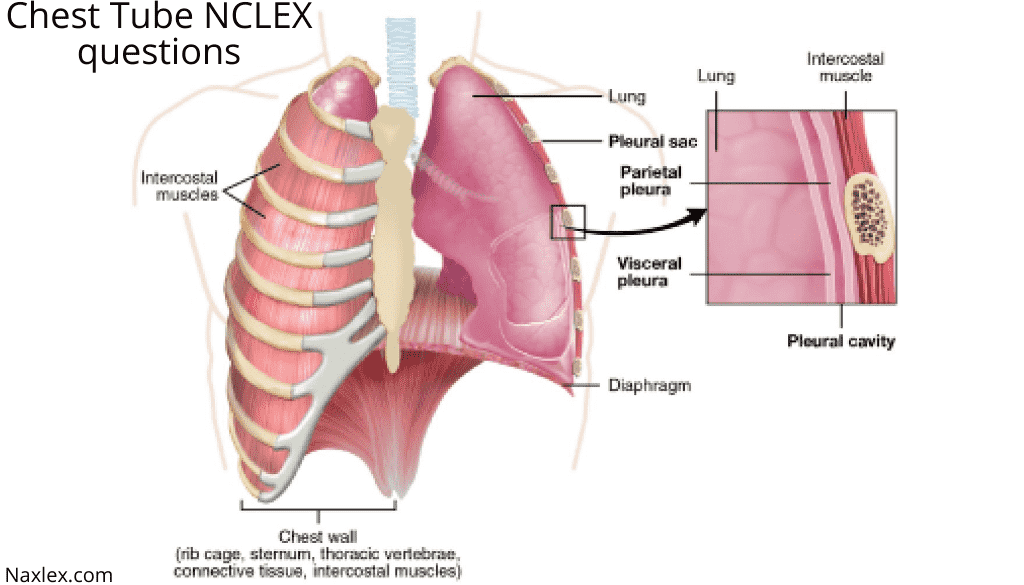Since chest tubes are quite common in hospital settings, you might be responsible for providing care for patients who have one at some point in your nursing career.
The NCLEX will have questions about chest tubes, so you ought to be ready for it. Chest tubes might be tricky for a nursing student, so to ensure you are knowledgeable, you might want to invest more time in practicing Chest Tube NCLEX questions.
How can Naxlex help?
Naxlex is the ultimate nursing resource for students. Our proven system has helped thousands of nursing students ace their NCLEX by reducing their study time, allowing them to survive their nursing school lectures and pass their exams! We guarantee a pass rate of 90%, with a money-back offer if you score 85% in our assessments and fail the actual exam. Try our premium package today!

An Overview of Chest Tubes Nursing Management
Chest tubes apply negative pressure and expand the lung when it has collapsed. Chest tubes also restore the normal negative pressure in the pleural cavity.
A chest tube is required in some cases, like surgery, a pneumothorax (air in the pleural space), pleural effusion caused by blood in the pleural space or hemothora, an empyema that is an infection in the pleural space, or a chylothorax (lymphatic fluid in the pleural space).
A chest tube can be put into any of these four pleural spaces (left, right, anterior, or posterior) in various ways, including a surgical incision in the chest wall or a needle puncture.
What to Know about Chest Tubes for NCLEX.
Chest tubes are a somewhat difficult subject, requiring extensive study time to comprehend the various types and chambers they link. You'll also want to grasp how chest tubes function and why a patient would need one.
The chest tube is inserted into the pleural space of the lung to assist the lung in re-expanding by eliminating air or fluid. After surgery, it may also be inserted into the mediastinum to drain blood or fluid from the area surrounding the heart.
Common reasons a patient may need a chest tube include:
Cardiac surgery
Pneumothorax (a collapsed lung)
Pleural effusion (fluid within the pleural space)
This hardly skims the surface of chest tube proficiency that could help you pass the NCLEX. Spend some time researching the topic of chest tubes, because there is a lot to learn. To prepare for chest tube questions on the NCLEX, focus on patient safety and priority evaluations.
What should nurses know about chest tube management?
Before taking the NCLEX, you should review several important nursing topics and interventions. There's a lot to know about chest tubes.
Something very important to understand is how to appropriately assess a patient with a chest tube and what to look for throughout your nursing exam.
Chest tube nursing procedures
Nursing examinations should concentrate on the respiratory system, including monitoring lung sounds, utilizing a pulse oximeter, and assessing the patient's breathing.
A patient with a new chest tube should be monitored for blood pressure and pulse, degree of consciousness, and capacity to breathe independently.
You should monitor your patient for signs of infection, such as fever, redness, edema, drainage from the insertion site, rapid heart rate, or low blood pressure.
Nurses are responsible for monitoring a chest tube's fluid intake and output.
Patient comfort is also crucial. Once safety has been assured, you can help the patient's comfort by providing adequate placement and pain management.
Risks: Chest Tube NCLEX questions
Inserting a chest tube is not without risk. The three most prevalent spots are subxiphoid, intercostal, and supracostal.
The subxiphoid is located just below the xiphoid process, about at the level of the ninth thoracic vertebra. It is an excellent drainage access point because it is simple to find and requires minimal dissection. However, because it is close to major organs like the liver and heart, there is a greater risk of problems during installation.
The intercostal gap lies between two ribs. It's also known as an "intercostal" drain since it drains into the heart via intercostal gaps (the area between ribs).
The supracostal is placed just above the sternum. This placement may be required if there are several wounds on both sides of the chest wall.
Nursing Care for Chest Tubes
Here's a checklist of nursing care management when it comes to chest tubes:
Assessment of lung sounds:
After every fifteen minutes, monitor the client's vital signs (blood pressure and pulse), their level of consciousness, and their ability to breathe independently.
Check for signs of infection, such as redness, swelling, or any discharge from the insertion site. Further, look for signs of hemolysis (RBC breakdown), like an elevated heart rate or low blood pressure.
Taking notes on fluid intake and output (the amount of fluid that passes through the tube).
Consider their comfort by adjusting and relieving discomfort and providing ice packs when needed. This also includes upgrading mobility through range-of-motion exercises as required.
Chest Tube Removal
Although removing chest tubes is a surgeon's responsibility, nurses can help the client heal and manage their pain. Sometimes, a nurse may be asked to assist surgeons with this process.
This entails administering gentle suction (via a suction tube) while keeping things sterile, ensuring that nothing gets inside where we need access to remove it.
Always keep baseline gauze on the nightstand if the chest tube is accidentally removed.
If a chest tube is disconnected from the collection chamber, there are two options:
Place the distal end in 250ml of sterile saline.
Chest tube injury caused by water seals.
Conclusion: Chest tube NCLEX questions
You will almost certainly care for a chest tube patient during your nursing career. Similarly, there's a strong possibility you'll see a chest tube question or two on the NCLEX. Because chest tubes can be difficult and confusing, it is best to devote adequate study time to them when preparing for the NCLEX. In addition to learning the topic information, you should practice answering questions that will aid you with critical thinking and prioritizing patient care. This comprehensive strategy will prepare you for the NCLEX and real-life scenarios you will encounter during your nursing career.
Start your journey with us today
Join 1000+ Nursing Students
Powerful learning and clinical tools combined into one platform. The Naxlex Knowledge and Qbanks give you instant and on-the-go nursing knowledge and guidance.




